03
TIPS FOR BUYING THE PERFECT TUBA OR EUPHONIUM
Buying a tuba or a euphonium is always an important decision that has to be thoughtfully taken.The price of these instruments is high, and, for that, we must be extremely cautious when it comes to investing our money in them.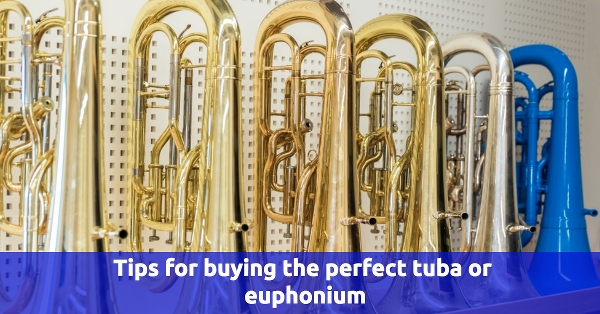
In this post I willl give you some pieces of advice that will help decide what instruments to choose.
I alays try not talk about brands or trademarks to my students or their families, instead I rather refer to differents types of quality.
From my poin of view, deciding between one instrument an another depends on its intended purpose. Once its use and quality are clear, we will look for the brand that best meets our needs.
What instrument should I buy?
To answer this question, we first have to take into consideration the level of the musician who is going to play this tuba or euphonium. The decision will be different depending on whether the person is a professional musician, an amateur player, or a beginner, intermediate or advance student.On the other hand, if the instrument is going to be played in a brass band or other music groups, we have to consider other aspects that might affect the final decision.
1º - Beginners or amateur musicians.
There are two main options for students at elementary levels or amateur musicians who are just beginning their training.1st - Buying a low/medium-quality instrument:
The price ranges between €600 and €900 for euphonium and €3.000 and €4.000 for tubas. These instruments are perfect for beginners, since they will last for 4 or 5 years, which is enough time to determine if the student is happy with the instrument and wants to continue his/her training.
If the students wants to quit, it´s a small investment and the instrument can be easily resold to a new student, which means that it´s possible to recover part of the original investment.
Nowadays all the brands manufacture instruments in various qualities, which make the choice much easier.
Below I mention some brans and models:
Euphonium:
- Jupiter 470 L.
- Gara GEP 74.
- Roy Benson.
- Willson 2727TA.
- Besson 1065-2.
- Thomann 902 or 904: These are very innovative models that have surprised us, providing quality at a reasonable price. Here you can read an analysis of the Thomann EP 902 Superior
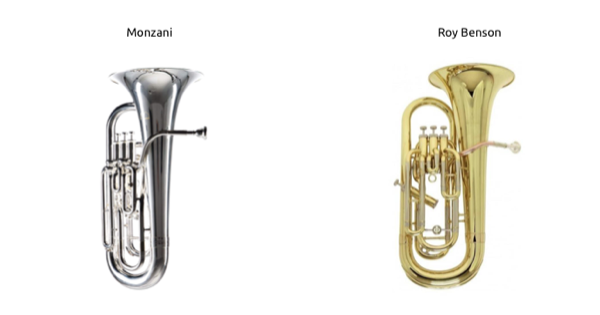
3/4 Tuba:
- Gara CGB 3/4.
- Jupiter JCB 774.
- Kalison.
4/4 tuba:
- St Peterburg.
- LGX 1500.
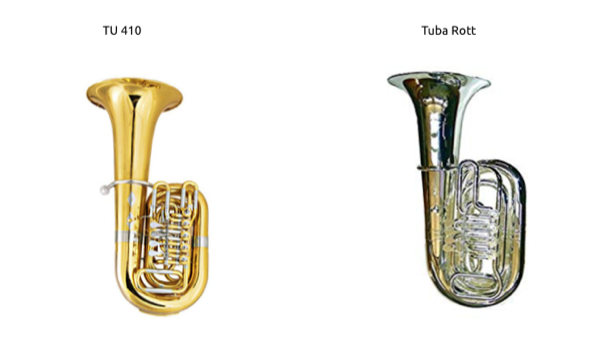
2nd - Buying a high-quality instrument:
A high-quality instrument has to be appropriate for it´s professional practice. If the student wants to continue his/her musical training, this is the best option - as long as the family can afford it.
On the other hand, it´s high quality will make it easier to sell and to recover a big part of the investment.
Medium-quality instruments are more difficults to sell on the second-hand market, although they normally work well in brass bands or amateurs music groups.
Euphonium: (always compensating sistem)
- Besson.
- Yamaha Yep 642 II NEO.
- Willson 2960 TA
Tuba:
- Yamaha YCB 621.
- B&S 4.097 L (PT 20).
- Miraphone - 85 B / 86 A / 88.
- Thomann Grand Fifty S - C Tuba.
2º - Professional training and higher education.
It´s highly recommended that students in the last year of their intermediate training or already in higher education courses buy a high-quality instrument.Prices range between €4.000 and €6.000 for euphoniums and between €6.000 and €14.000 for tubas.
Buying a hight-quality instruments entails a full commitment to the study (5-6 hours per day), which will lead to professional dedication.
An important factor that should be taken into account when buying a high-quality instruments is a that, if everything goes well, we won´t have to replace it with a new one. In other words, we are buying an instrumente that can last us for the rest of our musical career.
Buying a high-quality instrument entails studying for 5-6 hours per day.
Euphoniums:
- Besson 2052 Prestige.
- Besson 967 S Sovereign.
- Yamaha YEP 842S
- Miraphone M5050 Ambassador.
- Willson 2960 TA
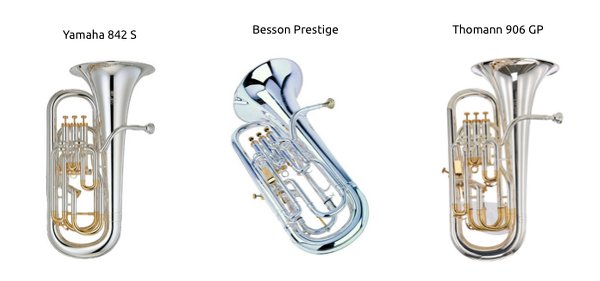
F Tubas:
- Melton 4460 / 45 / 45 s
- B&S 56 AFT-L / Perantuchi 5099 / JBL classic 3100 / MRF-F
- B&S Apollo 4100 II
- B&S Vulcano 4100 II P
- Miraphone Belcanto-Solo F 381 C / F 381 F
- Miraphone Firebird F281C / F281B
- Miraphone Petruschka F1281
Eb Tubas:
- Besson - BE 177 (Estudent)
- Besson - BE 984 (Professional)
- Miraphone Ambassador EEB M 7000 / 7050
- Miraphone Starlight 383B
- Walternirschl ES- tuba Modell MWN 4 / MWN 3
C Tubas:
- Melton 5450 Thor (5/4) (vídeo)
- Melton 5450 RA Tuono (5/4) - (vídeo)
- B&S Neptuno (6/4)
- B&S 3098 PT6
- B&S Perantuchi PT 20
- Hirsbrunner CC HBS 290 y 390 (4/4) / HBS 293 (5/4)
- Walternirschl C Tuba MWN 7 / MWN 8
- Miraphone 90 (5/4) / 291 (5/4)
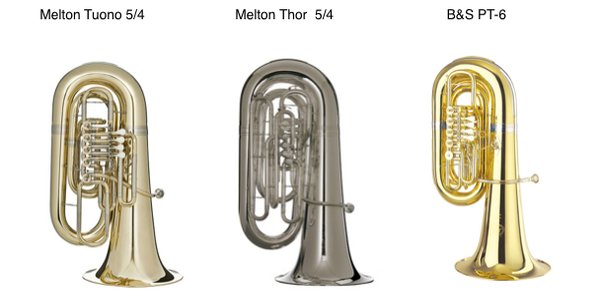
Bb Tubas: Currently this tipe of instruments is not very common in Spain, where we traditionally play the tuba in C. However, if we intend to get a job in other European countries, especially in Germany and Austria, playing in Bb will make things easier.
- Melton 195 L "Fafner"
- Melton 197
- Rudi Meinl "Bayreuth"
- Besson BE 187/186
3º - Amateur musicians:
There are plenty of amateur musicians that have their own instrument because they are passionate about tuba or euphoniums.My advice for these musicians is to buy an instrument with the highest possible quality, so it will motivate them and get them to devote more time to practicing.
Therefore, my recommendation is the same as for students in the last years of their intermediate training or starting in higher education courses.
4ª Music Bands:
Wind bands and brass bands play an essential role in teaching and promoting music in our contries, why they deserve their own section in this post.These music groups are formed by people of different ages and with different training, entailing very diverse needs.
Therefore, in order for these music groups to be successful it is very importan that they have the appropriate materials to face the different situations that might arise.
Ideally, they would have two types of instruments:
A - Low/medium-quality and small-size instruments: The band would provide these instruments to the new students that want to learn how to play them, with the objetive of attracting new members and contributing to childres´ early development.
Furthermore, families could borrow these instruments since little scratches or bumps due to daily use wouldn´t be very important.
The most recommendable sizes for tubas are compact 3/4 or 4/4. Ideally, music bands should have 2 or 3 euphoniums and 1 or 2 tubas to ensure that both sections of the band are always covered.
Euphoniums:
- J Michel.
- Roi Benson EP 302.
- Jupiter.
- Willson 2950TA /2960TA
Tubas:
- Yamaha YCB 621 (video)
- Jupiter JCB 774 Gimli.
- Gara CGB 80
B- High-quality and medium-size instruments: With these instruments we will allow children who started with 3/4 tubas to play higher-quality instruments when they are between 14 or 16 years old. They will be able to play bigger instruments in a short time, and it will encourage them to continue practicing.
On the other hand, these instruments also allow adults who want to play music as a hobby to master an instrument that is very useful in parades and processions, common events among music bands.
Euphonium:
- Besson.
- Yamaha YEP 642 S II NEO.
- Jupiter.
Tuba:
- B&S - 4097- L (PT20) / PT 6 (5/4)
- Hirsbrunner.
- ST Peterburg 209 S
- Miraphone CC 86 A / 86 B / 88 (4/4) / 90 B (5/4) /291 B (5/4)
5º - Instruments made of plastic.
In recent times new tubas and euphonium made of plactic came onto the market.
They offer multiple benefits because of their light weight, which makes them ideal for long parades.
They are also available in very bright colours, whitch make them very attractive for young children and helps to promote these instruments.
Another strong plus is thay they are cheaper, around €400 for a euphonium and €1.000 for a tuba.
Amazon offers very competitive prices for both instruments from the brand PlayLite:
You can buy the "Plastic Euphonium" clicking HERE.
You can buy the "Plastic Tuba" clicking HERE.
You can buy the Trumpet and trombone made of plastic clicking .
Here you can read a ANALYSIS OF THE TUBA MADE OF PLASTIC
FINAL REMARKS
Where to buy them: Every country has many shops with a wide variety of instruments and prices in their catalogues. Most of them work with high-quality instruments and offer a very professional service.It is highly recommended that the shop has instruments for you to try, as well as maintenance and repair service.
How to buy them: Once you have chosen the instrument you are interested in, it is important to consider the aspects listed below before actually buying it.
- Seek expert advice and, if in doubt, get a second opinion, specially if you are considering a high-quality instrument. You can seek expert advice from conservatorie teachers and orchestra musicians, among others.
- Compare prices in different shops. Ideally, you should compare the price of the same instruments, which normally does not vay much, but you might eventually find an interesting offer.
- Once you have chosen the instrument, the best hing would be to try differents models or request a trial period. I also recommend that a professional tests the instrument.
My recommendation is that you obtain as much information as you need and that you check that characteristics of the instruments meet your needs.
This post has been written in collaboration with "Alfonso Mollá Castells", euphonium professor at the Conservatorio Superior de Música de Asturias.(Higher Education Conservatorie of Asturias, Spain)
In the section ANALYSIS of this blog, you can find some test of tubas an euphoniums.














Leave a comment